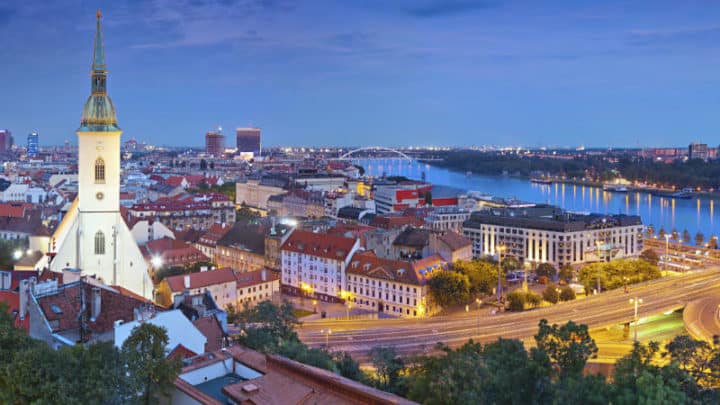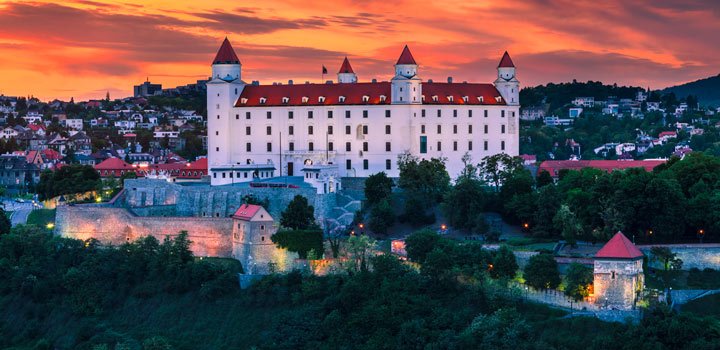
Gay Bratislava · City Guide
First time in Bratislava? Then our gay Bratislava city guide page is for you.
Book A Travel Gay Approved Hotel

Bratislava
Home to around half a million people, Bratislava is Slovakia's capital and largest city. It is close to the borders of both Austria and Hungary, and is in easy reach of the Austrian capital Vienna.
The history of Bratislava stretches back to Roman times, who introduced wine-making. In the communist period, it was decided that Prague would be the grand city of Czechoslovakia while Bratislava would be an administrative centre. This is reflected in soviet architecture and missing chunks of the city where medieval buildings lay.
Nowadays, Bratislava has the third highest GDP of the European Union and is an important hub for manufacturing, telecommunications, banking, and IT. It has a reputation of being a stag party destination. However, there are plenty of museums, cafes, historic sites and shopping opportunities for those after a more relaxed vacation.
Gay Rights in Slovakia
Same sex activity was legalised in 1962 and the equal age of consent (15) was established in 1990. Anti-discrimination legislation is in place and a 2013 amendment to the criminal code classed homophobia as a hate crime.
Slovakia is, however, relatively conservative when it comes to addressing same-sex issues as a bill to recognise same-sex marriage was voted against in 2012. In 2015, a referendum on amending the constitution's definition of marriage failed due to lack of voter turnout.
Religious beliefs prevail in Slovakia, with the Catholic church having a lot of influence here. In recent years, however, there has been a marked increase in public approval towards same-sex issues. This is especially noticeable in younger generations.
Gay Scene
Compared to neighbouring Vienna, Bratislava's gay scene is modest with a handful of bars and clubs and a single sauna catering for gay clientele. Bratislava is essentially the gay hub of Slovakia as outside of this city there is practically no gay scene anywhere else in the country.
While violence against gays is not common, it is not unheard. Social attitudes in Slovakia are a bit backwards, even in comparison to some of its ex-communist neighbours, so prudence is advised.
There is a pride parade in July that is supported by many of the foreign embassies in the city. There are some counter-protests, but generally the event is peaceful.
Getting to Bratislava
By plane
M. R. Štefánik Airport (BTS) or Bratislava Airport is located 9km north east of the city centre. It is mostly connected to other European, North African and Middle Eastern destinatons by charter and budget airlines with only limited connections to hub airports.
Busses 61 and 96 take you into the city centre during the day with services starting around 4.45am and finishing around 11.25pm (N61 hourly night service). Tickets can be bought from machines in arrivals, at the stop and from the Mediapress stall in departures. Journeys take around 20 minutes (location depending) and cost €0.70.
Taxis can be hailed from outside the terminal although to save time and get the better rate it is advisable to book in advance. Journey times are around 15 minutes and cost €15-20 if pre-ordered. If flagged at the airport you may end up spending closer to €30.
Vienna International Airport (VIE) is only 57 miles west of Bratislava and is a major international hub. You can take a bus for €7.20 and depending on where you want to go in Bratislava, taxis from Vienna can cost anything in the region of €40-140.
By train
Bratislava Central Station has excellent rail connections to central and eastern European destinations. Vienna is just an hour away, with sleeper services on to Berlin, Minsk and Moscow. The train station is about 1km away from the city centre but you can take a busses 93 and x13 take you into town. Taxis can also be hailed from the train station.
By boat
A river ferry service between Vienna and Bratislava takes you along the Danube from spring to fall. The journey takes around a similar time to the train and, unlike the train, stops in the heart of the city. Many Danube river cruises also stop at Bratislava on their route.
Getting around Bratislava
On foot
Bratislava is a great city for walking as the city centre is for the most part pedestrianised. You may expect the odd cyclist and the occasional car. The city centre is relatively compact, so it won't take long to cross from one side to the other. You'll only need to take public transport for longer journeys, if you have a lot of luggage or in bad weather.
By public transport
Public transport in Bratislava is cheap and efficient with an integrated network of trams, busses and trolley busses getting you from A to B. 15 minute singles start at €0.70 and 24-hour tickets starting from €3.50. You cannot get tickets from the driver, and you must remember to validate your tickets.
Most lines run from 4.30am until around 11.30pm. Most night lines are hourly and run to the main rail station and the presidential palace. During peak travel time the busses used can be quite old.
By taxi
Catching a taxi from outside the train or bus station will almost invariably result in you being ripped off. Most locals call a taxi however don't be surprised if the dispatcher does not speak English. Taxi apps such as Uber and HopIN are gaining popularity and eliminate any language problems.
Where to Stay in Bratislava
For some of the best and most popular hotels in Bratislava, please check out our Gay Bratislava Hotels page.
Things to See & Do

Bratislava Castle - believe it or not, but this castle was actually left in ruins by fire in 1811 and restoration only began in 1957. Not only is the building itself impressive, the cafe bar outside offers amazing views of the city. You can actually see the Slovakian, Austrian and Hungarian countryside from on top of this hill.
St Martin's Cathedral - Bratislava's largest church and built in the Gothic style. The concrete developments and busy road beside it diminish its effect but look closely at the spire. On the top is a gilded Hungarian royal crown.
SNP Bridge - this is one of the most divisive sites in Bratislava. Engineering aficionados praise the architectural ingenuity involved in its construction. Others think it's an eyesore Some say the restaurant in the "flying saucer" offers the best views in Bratislava because you can't see the bridge. It costs €6.50 to get to the top if not dining.
Church of St Elizabeth - also known as the Blue Church (or irreverently by locals as the Smurf Church) this art nouveau building is a must see. It puts Istanbul's Blue Mosque to shame when it comes to being blue.
Slovak National Theatre Building - beautiful Neo-Renaissance building that hosts classical performances. The fountain of Ganymede outside the entrance is particularly breathtaking. The National Theatre company has opened a modern new theatre that lacks the charm of the original.
Primate's Palace - the neo-classical residence of the Mayor of Bratislava. You can take tours inside and see the famous Hall of Mirrors (unless it's being used for a city council meeting).
Slovak National Gallery - the Bratislava branch of this art museum is located in the Esterházy Palace and has a great selection of Baroque art works. The Berlinka cafe is famous throughout Slovakia.
When to Visit
Slovakia is known for its spring blossoms and spring is a good time to visit as the weather is pleasant and mostly dry. Summer can get unbearably hot and the old town gets swarmed with tourists. Winters are cold but the dusting of snow does make the city appear quite charming, especially around the Christmas markets.
A variety of festivals are scattered throughout the calendar which draw people to the city. The Bratislava Music Festival in September and October attracts classical music lovers to the city whereas Cultural Summer from June to September brings performance and visual arts to the city. The annual gay Pride is held in July.
Visa
Slovakia is within the Schengen visa area. As it is part of the European Union, its visa requirements fall in line with what you would expect from most EU states.
Money
Slovakia became part of the Eurozone in 2009. There are many places to change money in town including banks and independent currency exchanges, although the rates can vary (even in banks) Debit cards are widely accepted in shops, restaurants and hotels. Do not risk changing money with street vendors.
Join the Travel Gay Newsletter
Have we got something wrong?
Are we missing a new venue or has a business closed? Or has something changed and we have not yet updated our pages? Please use this form to let us know. We really appreciate your feedback.